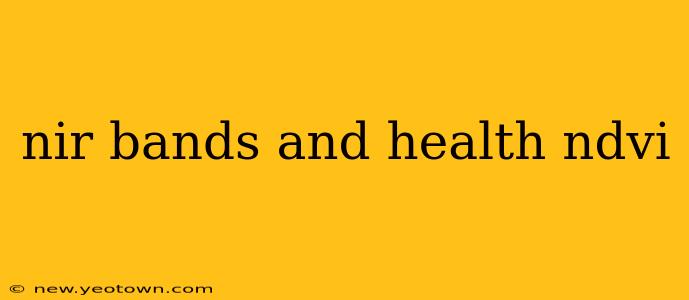The world is awash in data, and nowhere is this more apparent than in the realm of remote sensing. Imagine being able to assess the health of a vast forest, a sprawling agricultural field, or even a single plant from miles away – all without setting foot on the ground. This is the power of Near-Infrared (NIR) bands and the Normalized Difference Vegetation Index (NDVI). Let's delve into this fascinating field and unravel the secrets held within these spectral bands.
Our story begins with the sun. Sunlight, that life-giving energy, is composed of various wavelengths, including visible light and near-infrared radiation. Plants, in their remarkable efficiency, absorb some of these wavelengths and reflect others. This is where NIR bands come into play. They detect the near-infrared light reflected by vegetation, providing a crucial insight into its health and vigor.
What are NIR Bands?
NIR bands are specific portions of the electromagnetic spectrum, typically ranging from 700 to 1300 nanometers (nm), just beyond the visible red light we can see. These wavelengths are invisible to the human eye but are readily detected by specialized sensors, such as those found in satellites and drones. The higher the reflectance in these bands, the healthier the vegetation generally is. This is because healthy plants have a high concentration of chlorophyll and other pigments which efficiently absorb visible light for photosynthesis, but reflect a larger portion of near-infrared light.
What is NDVI?
The Normalized Difference Vegetation Index (NDVI) is a powerful tool that leverages the information from NIR bands. It's a simple yet effective calculation that compares the reflectance of near-infrared light (NIR) to the reflectance of red light (Red). The formula is:
NDVI = (NIR – Red) / (NIR + Red)
This ratio provides a normalized value ranging from -1 to +1. Higher values generally indicate healthier, more vigorous vegetation, while lower values suggest stress or even death. A value close to zero indicates bare soil or water.
How is NDVI used in assessing plant health?
NDVI's applications are vast and varied. Imagine a farmer monitoring crop health across hundreds of acres. Traditional methods are time-consuming and labor-intensive. With NDVI, they can quickly identify areas experiencing stress due to drought, disease, or nutrient deficiencies. This allows for timely intervention, improving yield and reducing losses. Similarly, foresters use NDVI to monitor deforestation, track forest health, and assess the impact of wildfires.
What are the different types of NDVI calculations?
There isn't a multitude of fundamentally different NDVI calculations. The core principle remains the same: comparing NIR and red reflectance. However, the specific wavelengths used for NIR and Red can vary slightly depending on the sensor used. These variations are generally minor and the interpretation remains largely consistent. The key differences arise from the application of NDVI rather than the calculation itself. For example, one might use NDVI derived from satellite imagery at a coarser resolution for large-scale monitoring, while drone-based NDVI provides much higher resolution for detailed analysis of individual plants or small fields.
What are the limitations of using NDVI to assess plant health?
While NDVI is a powerful tool, it's not without limitations. Atmospheric conditions like clouds and haze can affect the accuracy of measurements. Similarly, the presence of shadows can skew the results. Furthermore, NDVI doesn't differentiate between different types of vegetation. A lush, healthy forest might have a similar NDVI to a dense field of weeds. Finally, very dense canopies can saturate the sensor, leading to inaccurate readings. Despite these limitations, NDVI remains an invaluable tool in remote sensing and continues to play a crucial role in monitoring plant health globally.
What are the benefits of using NIR bands and NDVI?
The benefits are numerous: early detection of plant stress, improved crop management, efficient resource allocation, monitoring of large areas, and early warning systems for environmental disasters. NDVI empowers us to manage our resources sustainably and protect our planet's precious ecosystems.
The story of NIR bands and NDVI is a testament to the power of technology in understanding and managing our environment. As technology advances, we can expect even more sophisticated techniques to emerge, building upon this foundational work to provide even more accurate and insightful data about plant health and the planet itself.

